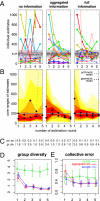How social influence can undermine the wisdom of crowd effect
- PMID: 21576485
- PMCID: PMC3107299
- DOI: 10.1073/pnas.1008636108
How social influence can undermine the wisdom of crowd effect
Abstract
Social groups can be remarkably smart and knowledgeable when their averaged judgements are compared with the judgements of individuals. Already Galton [Galton F (1907) Nature 75:7] found evidence that the median estimate of a group can be more accurate than estimates of experts. This wisdom of crowd effect was recently supported by examples from stock markets, political elections, and quiz shows [Surowiecki J (2004) The Wisdom of Crowds]. In contrast, we demonstrate by experimental evidence (N = 144) that even mild social influence can undermine the wisdom of crowd effect in simple estimation tasks. In the experiment, subjects could reconsider their response to factual questions after having received average or full information of the responses of other subjects. We compare subjects' convergence of estimates and improvements in accuracy over five consecutive estimation periods with a control condition, in which no information about others' responses was provided. Although groups are initially "wise," knowledge about estimates of others narrows the diversity of opinions to such an extent that it undermines the wisdom of crowd effect in three different ways. The "social influence effect" diminishes the diversity of the crowd without improvements of its collective error. The "range reduction effect" moves the position of the truth to peripheral regions of the range of estimates so that the crowd becomes less reliable in providing expertise for external observers. The "confidence effect" boosts individuals' confidence after convergence of their estimates despite lack of improved accuracy. Examples of the revealed mechanism range from misled elites to the recent global financial crisis.
Conflict of interest statement
The authors declare no conflict of interest.
Figures


Comment in
-
Social influence benefits the wisdom of individuals in the crowd.Proc Natl Acad Sci U S A. 2011 Sep 6;108(36):E625; author reply E626. doi: 10.1073/pnas.1109947108. Epub 2011 Aug 26. Proc Natl Acad Sci U S A. 2011. PMID: 21876181 Free PMC article. No abstract available.
References
-
- Galton F. Vox populi. Nature. 1907;75:7.
-
- Lorge I, Fox D, Davitz J, Brenner M. A survey of studies contrasting the quality of group performance and individual performance, 1920-1957. Psychol Bull. 1958;55:337–372. - PubMed
-
- Hommes C, Sonnenmans J, Tuinstra J, van de Velden H. Coordination of expectations in asset pricing experiments. Rev Financial Stud. 2005;18:955–980.
-
- Yaniv I, Milyavsky M. Using advice from multiple sources to revise and improve judgments. Organization Behav Hum Decis Process. 2007;103:104–120.
-
- Surowiecki J. The Wisdom of Crowds: Why the Many Are Smarter than the Few and How Collective Wisdom Shapes Business, Economies, Societies, and Nations. New York: Doubleday Books; 2004.
Publication types
MeSH terms
LinkOut - more resources
Full Text Sources
Other Literature Sources
Molecular Biology Databases

